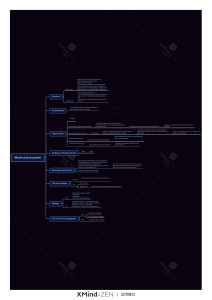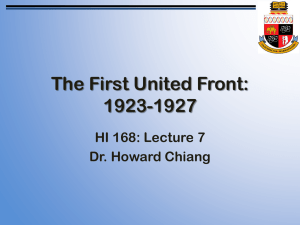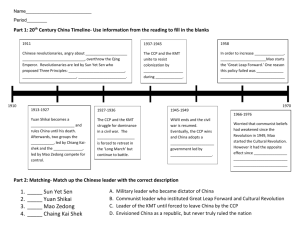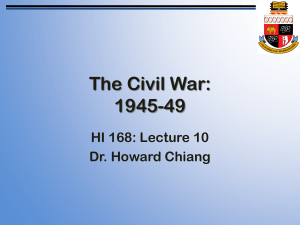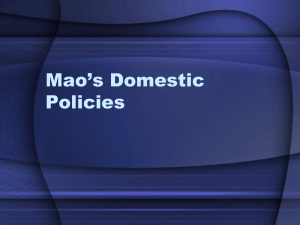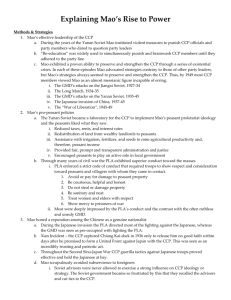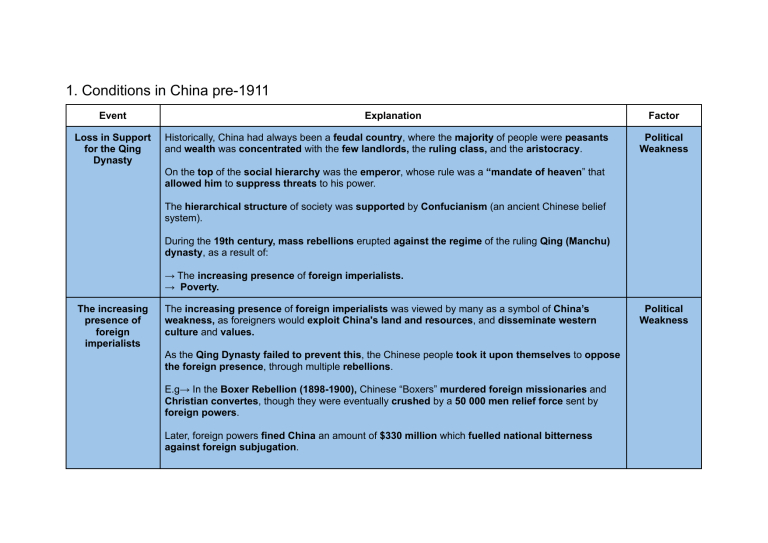
1. Conditions in China pre-1911 Event Loss in Support for the Qing Dynasty Explanation Historically, China had always been a feudal country, where the majority of people were peasants and wealth was concentrated with the few landlords, the ruling class, and the aristocracy. Factor Political Weakness On the top of the social hierarchy was the emperor, whose rule was a “mandate of heaven” that allowed him to suppress threats to his power. The hierarchical structure of society was supported by Confucianism (an ancient Chinese belief system). During the 19th century, mass rebellions erupted against the regime of the ruling Qing (Manchu) dynasty, as a result of: → The increasing presence of foreign imperialists. → Poverty. The increasing presence of foreign imperialists The increasing presence of foreign imperialists was viewed by many as a symbol of China’s weakness, as foreigners would exploit China's land and resources, and disseminate western culture and values. As the Qing Dynasty failed to prevent this, the Chinese people took it upon themselves to oppose the foreign presence, through multiple rebellions. E.g→ In the Boxer Rebellion (1898-1900), Chinese “Boxers” murdered foreign missionaries and Christian convertes, though they were eventually crushed by a 50 000 men relief force sent by foreign powers. Later, foreign powers fined China an amount of $330 million which fuelled national bitterness against foreign subjugation. Political Weakness Feeling pressured, emperor Guang Xu launched the “Hundred Days Reform” (1898) which aimed to modernise bureaucracy, the armed forces, and the transportation system. This reform, however, was halted by empress Cixi, who became China's actual ruler after the 1861 coup. Poverty Poverty also triggered mass unrest in China as most of the population had a terrible quality of life: Economic factors Although peasants were 80% of the population, only 10% of land was arable, most of which was unusable due to flooding and natural disasters. This made it hard for people to survive, as many died of famine due to the inability of growing crops. This worsened as China’s population rose from 120 million in 1712 to 440 million by 1900. Peasants also suffered with debt as they forcefully paid 50-80% of their crops as rent to landlords, and would frequently have their lands vanquished by Chinese armies. On the contrary, wealth was concentrated with few, as landlords and prosperous peasants were only 10% of the population but owned 70% of land. The Spread of Revolutionary Ideas As a result of the growing foreign interference, the weakness of the Qing dynasty, and mass poverty, revolutionary ideas arose. Sun Yatsen was the leader of the Revolutionary Alliance founded in 1905, which consisted of young revolutionaries, most of which were peasants, townspeople and students. The revolutionary league was founded on 3 principles: 1. Nationalism 2. Democracy 3. Improving people’s quality of life through socialism Ideology 2. The 1911 Revolution and the Creation of the Republic The 1911 Revolution In October 1911, China’s last imperial dynasty was toppled after an outbreak of revolutionary conspiracy in army units in Southern China, which overthrew Empress Cixi. Military factors/ violence Although Sun Yatsen was away at the time, he returned in December, and was appointed President of China by the Revolutionary Alliance in Nanjing. However, the revolutionaries were not strong enough to completely take over from the imperial government, and holistically consolidate the revolution and needed military support. Hence, the rebels broke a deal with the military, in which the military agreed to support the revolution, but Yuan Shikai, a powerful imperial general, had to become President instead. The rebels agreed, and after emperor Puyi abdicated in February 1912, the Republic of China was formed. President Yuan Shikai Now in power, Yuan Shikai proved rather unfaithful to the revolutionary ideals of the 1911 revolution: → In 1913, he called for parliamentary elections but when the National Revolutionary Alliance, now called the GMD (National People’s Party) won, Shikai banned the GMD. → In 1914, he shut down parliament and ruled China as if he was emperor. Shikai also proved unable to resolve many of the long-standing issues of the Qing Dynasty, including failing to stand up for foreing aggression: → In 1915, he agreed to most of Japan’s imposed “Twenty-One Demands”. These included: - The transfer of some German privileges in Shandong to Japan. Japanese rights to exploit mineral resources in Manchuria. Shikai died in 1916, leaving China weak and divided. Political Weakness 3. The warlord period, 1916-1927 The lack of a central authority Following the death of Shikai in 1916, there was no effective central government in China until 1917. Political Weakness There was a government in Beijing, which although recognized by foreign powers, had little authority in China. Rather, power was concentrated with warlords, who controlled different regions in China. Often, war between warlords would break out, which was detrimental for peasants as: → They had to pay high taxes and frequently saw their land looted by invading armies. Anarchy and division meant foreign powers easily interfered in China, especially as China was weakened by the loss of territory including: Tibet, Xinjiang, and outer Mongolia. Sun Yatsen and the GMD had attempted to establish a government in Southern China, and planned on launching a northern military expedition aiming to reunify China. This, however, depended on the support of regional warlords, which was difficult to achieve, as a strong central government would mean less power for the warlords. Sun fled to Shanghai in 1922. WWI & The May To regain the people's trust, and boost their power status, The weak government in Beijing Fourth Movement decided that China should enter WWI because if it was a victor, it could boost their power status, (1919) and thus regain the people's trust. Hence, with this increased morale, they could fully take over control of China from the warlords. However, unfortunately for the government in Beijing, the end of WW1 furthered China’s humiliation. Impact of war In 1916, China aided the Allies by sending 95 000 labourers, most of which were peasants, to help with the war effort against Germany, and it was estimated that around 20 000 of these peasants died throughout the war. The high casualties (a sign of great sacrifice) made China hopeful that it would be well rewarded in the ToV, with the return of Shandong to China. However, the ToV gave the German concessions in China to Japan, triggering student protests in Beijing on May 4th 1919. Thousands of students attended the protests, denouncing Japan's Twenty-One Demands and expressing how they felt betrayed by western powers, and were furious at Japanese expansionism. The emergence of Mao and the CCP (1921) The May Fourth Movement eventually culminated in the emergence of the Chinese Communist Party (CCP) in 1921. Political Strategy The CCP was founded in Shanghai and encouraged by the Russian Comintern, which was key to its success, as the party would be greatly financed and supported by Russia. Mao Zedong was a founding delegate of the Party; a Marxist that eventually rose to the leadership of the CCP, and of China. From this point onwards, Mao and the other 49 founding delegates of the CCP, would attempt to establish a communist regime in China that, in their view, would protect the nation from western imperialism, capitalism, and finally bring fairness and prosperity to the Chinese people. Sun Yatsen’s possible alliances Having returned from exile in the 1920s, Sun Yatsen knew that neither the GMD nor the CCP were strong enough to achieve power. China was still amply under warlord control, so Sun Yatsen believed in 2 alliances that could potentially strengthen the nationalists: 1. An alliance with the Christian warlord Feng Yuxiang, who controlled Beijing, and besides Political Strategy being sympathetic to GMD policies, he had the military strength to support the GMD. 2. An alliance with the CCP, who had become a disciplined political party to which much of the left-wing of the GMD was sympathetic to. A merger of the parties could broaden national appeal to the GMD. 4. The Emergence of Mao and the CCP The First United Front (1924) Supported by the Russian Comintern, the CCP formed an alliance with the GMD, despite their ideological differences, forming the First United Front in 1924. Their goal was to: - Defeat the warlord. - Crush foreign interference. This was necessary for the CCP as a communist regime was only achievable if these obstacles were ended. However, the CCP was the inferior partner in this alliance, becoming a bloc of the GMD, and accepting the GMD control and discipline. Both parties prospered from the alliance, seeing a growth in support: → CCP membership skyrocketed from 57 members in 1921 to 58 000 by 1927. → The GMD saw an increase in support and was strengthened by the establishment of the Whampoa military academy in 1924. After Sun Yatsen died in 1925, Chiang Kai Shek arose as the leader of the United Front, following a brief power struggle. Chiang Kai Shek was part of the right wing of the GMD, and thus suspicious of the CCP. Use of Force His rise to the leadership was very significant, as his rival, Wang Jingwei, from the left wing of the GMD was more lenient with the CCP, and may have been more willing to preserve the United Front. Nevertheless, a cooperative military campaign against warlords was launched, known as the Northern Expedition The Northern Expedition (1926-28) The Northern Expedition consisted of around 100 000 men, who left Guangzhou (in southern China) in May 1926, and targeted Fujian, Jiangxi, and Nanjing (in northern China). The goal of the expedition was for GMD troops to reunify China as they marched towards the north, taking control from the warlords along the way, broadening their national appeal, and finally establishing a legitimate national government. Led by Chiang Kai Shek, the expedition rapidly advanced and in a few months, its forces were bound to take Nanjing and Shanghai. However, this military success came at a cost, as Chiang had brokered deals with several warlords in exchange for their support of the GMD. Hence, some warlords continued to be very powerful, as they continued to control some regions of China. Additionally, this “success” also resulted in rising tensions within the alliance. As Chiang and the GMD troops advanced, Mao grew more active within the GMD and CCP in Shanghai, which was pivotal for his rise to CCP leadership. At this time, he was less concerned with national CCP issues, and was seen by peasants as their leader against warlords and landlords. E.g→ In 1926, he returned to Hunan where he organised peasant associations to support the United Front. Use of Force Communist activism in the cities and countryside was extremely beneficial for the Expedition, though Chiang saw this as a threat, as: → He feared that communist-promoted strikes could undermine middle-class support. → The success of the Communists was linked to the success of the left-GMD, leading Wang Jingwei to bid for GMD leadership. The White Terror (1927) In the spring of 1927, Chiang Kai Shek sought to reassert his authority and GMD supremacy by turning on the communist bloc of the United Front. He was supported by multiple groups, including: landlords, warlords, criminal organisations, Western groups, etc. Chiang achieved this by: → “purging” communist organisations in Shanghai → Violently confronting union members, communists, and peasant associations in Wuhan and Hunan. These events became known as the “White Terror”, in which thousands were killed. This resulted in the collapse of the United Front, in which the aftermath was: → Wang Jiengwei renouncing his claim to GMD leadership, and supporting Chiang. → Zhang Zoulin, the Manchurian warlord, seizing control of Beijing and joining forces with the GMD. Chiang established a nationalist government in Nanjing, officially ending the Warlord Era, and setting off the Nanjing decade (1928-37), in which China was torn by a civil war. Military Factors/ violence The fate of the CCP was amply reliant on Mao. The Jiangxi Soviet (1927-34) Mao survived the White Terror and retreated to the Jiangxi province in southeast China, together with CCP forces. Political Strategy There he established his base as the Jiangxi soviet territory, which had a population of 1 million. This was also where: → Mao continued to conduct party activities and formalised the CCP's doctrine. → The Red Army developed a strong guerilla force to resist GMD extermination campaigns. Whilst in the Jiangxi Soviet, Mao also began to develop a Maoist form of communism: → Mao aimed to achieve a peasant revolution, which contradicted the Comintern and pro-Moscow positions that the communist revolution was to derive from the urban workforce (proletariat). E.g→ Although Moscow ordered Mao to base CCP activities in towns, he conducted them in the rural areas. It was clear that Mao believed in a peasant-led revolution: E.g→ In his 1928 “Land Law”, he sought to take land from landlords and redistribute to peasants. Mao believed that the revolution needed to be led by the peasants because they were the largest social class in China, whereas the proletariat was still underdeveloped, and thus not strong enough to successfully achieve a communist revolution. The Futian Incident (1930) In the Futian Incident, Mao ordered that 4000 Red Army troops be tortured and executed. Mao sought to punish the Red Army as he regarded them as rebels who conspired against him, as they supported other leaders in the CCP. Use of Force This evidenced Mao’s brutality against his rivals, which became common to deal with opposition. The Long March (1934-35) In 1931 the Japanese invasion of Manchuria greatly weakened China, however, although the GMD was the official government of China, Chiang still prioritised crushing the communists, rather than resisting Japan. In 1934, GMD forces encircled the Jiangxi Soviet, hoping to: → Starve the CCP, leading to their defeat. → Capitalise on the “blockhouse” military strategy, in which GMD forces built defensive fortifications, allowing them to consolidate their position, and hunt down the communists. The Red Army attempted to combat these GMD forces by employing guerilla tactics, yet these resulted in major defeats for the CCP. Hence, Otto Braun (Li De), the Comintern adviser to the CCP, persuaded the Revolutionary Military Council to abandon guerilla methods. This led Mao to be relegated from leadership, as he strongly advocated for guerilla methods. Still, the GMD further advanced. Facing annihilation, about 100 000 CCP troops set on the Long March, as they fled Jiangxi, heading to northwest China. The Long March was 11 000 km long and took over a year to complete; although it later provided the CCP with inspiring legend that was used for propaganda. However, in reality the Long March was more bleak, as only 20 000 troops survived, although this remained proof that the CCP beat the odds. → There is evidence suggesting that Mao was not the initial leader in the Long March. Many Military Factors/ violence believe Mao made a comeback to leadership by outmanoeuvring his opponents, like Otto Braun and the Comintern members. He did this by arguing the CCP should readopt guerilla methods, and he was supported by Zhou Enalai. Mao’s consolidation of support in Yanan (1935-45) Following the Long March, troops had arrived in Yanan, where Mao used political, military and repressive methods to assert his authority. Mao faced 3 challenges: 1. Threats to his leadership by CCP members or the Comintern. 2. The need to build a CCP support base, with popular support and military recruits. 3. Ideological struggles within the CCP. The methods utilised by Mao were later contributing to the CCP’s triumph in the Civil War and against Japan. Mao won support of peasants through: → land redistribution, rent controls, campaigns to improve literacy, and end corruption. → Involving peasants in “revolutionary committees”. → The adoption of ‘mass line tactics’, in which the CCP built a strong relationship with peasants, as CCP cadres often lived amongst peasants. Mao even established the “Six Principles of the Red Army” which attempted to make the army polite, and gain peasants’ support: E.g→ These principles included, returning what was borrowed, and “paying for all things broken, even chopsticks.” Also, as Japanese presence increased in China, Mao invigorated his nationalist stance, condemning invaders. Mao’s leadership In all, CCP membership soared from 58 000 in 1927 to 1.2 million by 1945. Mao also built a strong ideological base in Yanan by: → Publishing philosophical and political works, marking his authority in the CCP. → Launching “reunification campaigns” in 1942 to remove potential opposition. → Forcing potential threats to publicly confess their crimes, and stripping them from their positions. → Enforcing strict censorship in Yanan, in such a way that outside information was controlled. → Promoting “Self-criticism” in which people were encouraged to reveal their mischievous behaviours. - This was extremely difficult, as those that did not self-criticise were deemed suspicious, and those that overly self-criticised could be punished. By 1943, a cult of personality was emerging as Mao adopted leadership roles like Chairman of the CCP, and the CCP ideology was officially “Mao Zedong thought”. 5. The Japanese Occupation, 1931-45 The Japanese Invasion of Manchuria (1931) The Second United Front (1937) Following the Mukden Railway Incident, the Japanese army invaded Manchuria, by making it a puppet state, whose puppet ruler was the last Chinese emperor, Puyi. Use of Force Puyi agreed to support Japan as he sought to return to his throne. Chiang Kai Shek, the leader of the GMD government, effectively failed to resist Japan’s aggression, as he prioritised suppressing the CCP. In the Xian Incident of 1936, Zhang Xueliang, who was Chiang’s second in command, had refused orders to attack the communists, and rather placed Chiang in house arrest. Political Strategy Zhang believed that Chiang was foolish in targeting the Communists, rather than the Japanese. Following this event, Zhang received a letter from Mao, Zhou Enlai, and Zhu De, urging him to end the civil war, and unite with the communists to fight Japan. Chiang reluctantly agreed, and thus the Second United Front was formed in 1937. This time, however; the CCP was dominant, establishing a stronger nationalist credentials than the GMD. The Sino-Japanese War (1937) In 1937, Japan launched a full-scale invasion of China, setting off the Sino-Japanese War, and established a government in Nanjing in what became known as the Rape of Nanjing Military factors/ violence Hence, the entire eastern Chinese seaboard was under Japanese control, which was very detrimental to the Chinese. Although at this time China was more united than ever, the Sino-Japanese war was a major factor in weakening the GMD and strengthening the CCP. The end of the Second United Front (1941) In 1941, GMD forces turned on the communists in southern China, effectively ending the Second United Front. Political weakness This was detrimental to Chiang’s popularity both domestically and internationally. E.g→ Initially, the USSR was the only country assisting China, but in 1941, the USA sent approx $500 million in military aid. Various international missions were sent to reestablish the Second United Front, but Chiang’s stubbornness only widened the gap between the GMD and the CCP. Chiang and the GMD weakened Not only was Ching and the GMD losing support, but the GMD was weakened by corruption. E.g→ GMD troops often sold food on the black market, and rice bags would be half full of sand. Political weakness However, Chiang appeared to ignore these weaknesses, which only culminated in the GMD’s collapse. Conditions for GMD soldiers were terrible, as they often tried to flee to the CCP, many of which were tied up at night to prevent desertion. Peasants were also hit by the GMD rule due to conscription, sickness, and starvation. Chiang was titled Generalissimo as he grew increasingly dictatorial, making use of his secret police to arrest, toruture, and execute civilians. He suppressed all expressions of discontent, culminating in intellectuals becoming communists. The economy was also in decline, which damaged the GMD base, the middle-class. Noticeably: → Inflation was out of control, which worsened as Chiang’s solution was to print money which led to hyperinflation. → Cities had different exchange rates, making prices very unbalanced. → The government increased taxes, which were mainly levied on peasants. These cases benefitted Mao, as it gave him moral credibility over Chiang. The effect of the Japanese invasion on CCP support As Japan expanded, and the GMD lost support, the GMD was pushed southwards. Political strategy This and the fact that the GMD was scarcely spread, meant it was weakened, paving the way for the CCP to control northern China and most of the countryside. By the end of the Japanese invasion, the CCP controlled an area occupied by 90 million Chinese. Later, Mao even admitted that the “Japanese occupation had saved the communists”. The end of the In 1945, the atomic bombs in Hiroshima and Nagasaki marked the end of the Sino-Japanese War. Political Sino-Japanese war & the new world order (1945) Weakness China emerged victorious, however peace far from present, as a GMD-CCP coalition was virtually impossible. This was worsened by the emergence of a new world order: The USA and the USSR which had conflicting interests in China and Asia: → The USSR wanted to strip Manchuria from its industrial resources, and would back the CCP. → The USA was concerned about Soviet interest in China, as it could lead to China’s dominance in Asia, and hence the USA backed the GMD. In 1946, President Truman and Sec. of State George Marshall attempted to broker a deal between the GMD and the CCP. Truman hoped that this would bring political stability, thus ensuring a non-Communist controlled China. Both sides agreed but by July a Civil War broke out between the GMD and the CCP. 6. The Chinese Civil War, 1945-49 The GMD’s superiority (1946-47) As war broke out, the odds of a CCP victory were very slim as: → GMD armies outnumbered CCP 4:1. Military Factors/ violence → The GMD was internationally recognized as the legitimate government (even by the USSR). → The GMD controlled most large cities and the railway network at the beginning of war. → By 1947, the GMD had taken Yanan from the communists. Still, the CCP was supported by the USSR, who provided military assistance and aid. The CCP’s By 1948, the direction of the war started to change as: Use of Force comeback (1948) → The CCP used their guerilla training to hold control of Northern China, and the countryside. → The CCP had received weapons from the Soviets. → Mao disobeyed Stalin’s orders to leave the cities to the GMD, as the CCP invaded and took control of cities. By June 1948, CCP troops were almost equal in number to GMD troops. Although the USA provided limited aid to the GMD, it withdrew support in 1948, as it was clear the GMD would lose. The CCP’s increased popularity. In parallel to military advances, the CCP won popular support, as Mao effectively used propaganda. Mao’s leadership CCP troops were extremely disciplined, and the communists were broadly supported by peasants. However, peasants against the CCP were heavily suppressed, and forced to fight for the CCP against the GMD. → Mao’s eldest son, Anying was sent to the country to suppress unsympathetic peasants. He later described having seen atrocities worse than anything he had seen in the USSR, calling party cadres “thugs”. Opposingly, the GMD grew unpopular, as a result of corruption, inflation and repression. Chiang Kai Shek’s mistakes Chiang Kai Shek made some grave military mistakes that cost him the war. → He sent troops to Manchuria before establishing control of northern and central China. → There was poor communication between generals which meant that supply lines did not run smoothly. Military Factors/ violence By 1948, the GMD had lost Manchuria, and Mao’s cult of personality was astronomical, giving the CCP more confidence. Additionally, the CCP grew more militarily superior as those that had left the GMD provided them with weapons. The CCP’s strategies were improved as Lin Biao had a military expertise that made the Red Army a strong fighting force. The End of the Civil War (1949) By January 1949, the CCP controlled Beijing, the south and west. Chiang realised that the GMD would lose and so resigned from the Presidency, and moved his support base to Taiwan. The communists proclaimed victory, and the People’s Republic of China (PRC) was established in October 1949, with Mao Zedong becoming Chairman and President. Mao’s leadership
